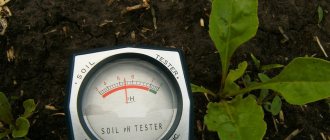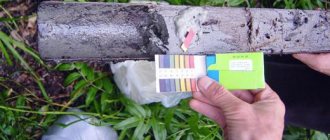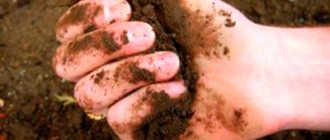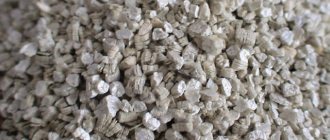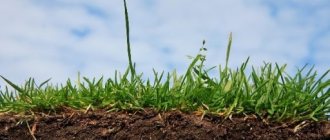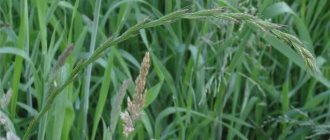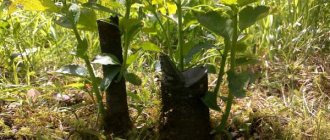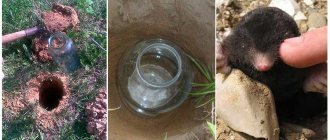How to Improve Clay Soil
Despite the significant disadvantages of such a site, it is possible to change the structure of clay soil. However, this will require large physical and material costs. In addition, the work itself can take several years.
- To begin with, it is important to eliminate uneven terrain. This way you can avoid stagnation of water after rains and melting snow.
- For the winter, it is better to dig up the soil without breaking up the lumps. It is better to do this before the onset of autumn rains, so as not to compact the soil even more. In winter, the structure of such lumps will improve under the influence of frost and moisture. This accelerates the spring drying and warming of the soil. In the spring, such soil needs to be dug up again.
- Simultaneously with organic matter, significant doses of river sand are added during autumn digging. This effective technique is very labor-intensive, since the plants use organic matter, and the sand gradually seeps down. The top layer becomes heavier again. But still, by adding organic matter and sand over 5 years, the arable layer can be turned from clay into loam.
- Make permanent beds by enclosing their walls with boards. It is easier to care for such beds. In the fall, they can be dug up and topped with a layer of fallen leaves, sawdust, and hay. In the spring, it’s good to pour Baikal, Um, with the preparations, add humus or peat, dig it up. By constantly adding mulch, the fertile layer will build up over time.
My fertile soil is clay
My husband and I had a dream - to buy a house on earth. How nice it is to have a plot near your house and grow cucumbers and tomatoes on it. Our plants will receive a lot of care and attention, which means the result will not be long in coming. We made our dream come true - we bought a house on 12 acres. They took up farming with passion, but were disappointed in the first year.
Elena Lekomtseva and Sergey Bespalov about surface tillage
All stories from the special issue “New Secrets of High Yields”
The soil on the site turned out to be clayey and could not be cultivated. Sticking a shovel into the soil required a lot of effort. Digging the earth turned into hard labor. We spent the entire spring with a shovel in our hands, and the soil remained dense, like cement. The plants suffered, became sick, and were constantly eaten by pests. We saw almost no harvest, despite the fact that we spent a lot of time on the site: weeding, loosening and watering. In order to grow something, they began to increase the number of plantings. And we had a saying: “We take quantity, not quality.”
We quickly got tired of such farming and switched to products from markets. They began to plant the vegetable garden with potatoes; the land should not be left empty. But the potato harvest was disastrous.
- How's the neighbor's harvest today? - More than ever! I planted a bag of potatoes, collected a bag, and not a single one was lost!
Two years ago we learned about natural farming on the Internet. The idea that soil fertility could be restored and the earth could be made loose and alive brought us back to the desire to start farming again. Without a shadow of a doubt, we decided that we would make our clay soil loose, alive and fertile.
The first thing we did was cross the shovel off the list of our “friends” and bought a Fokina flat cutter. It turns out that in order for the earth to recover and feed our plants, it cannot be dug, but must be loosened to a depth of 5-7 cm.
In addition, with a flat cutter we can easily, without bending, cut off weeds, green manure, and make grooves.
Our new first spring
When the snow melted, we very quickly loosened the top layer with a flat cutter and sown half of the area with green manure.
We planted crops at our own time, starting in May. They loosened the ground with a flat cutter, formed beds with it, cut furrows and sowed seeds. Little time and labor was spent on planting.
Potatoes were planted directly on the ground in furrows:
The potatoes were covered with a thick layer of hay:
And then everything turned out to be simple. The plants grew, and we mulched the beds with a thick layer of grass from green manure that grew on our site. We treated with bio-cocktail once a week.
I prepare a bio-cocktail like this: For 10 liters of water I take 20 Ecoberin granules, 20 Healthy Garden granules, 20 drops of HB-101 and 1 tablespoon of Radiance-1 biosolution. Mix well until the granules dissolve and the bio-cocktail is ready!
No weeding, endless watering and loosening. The plants looked healthy and beautiful.
It was the happiest summer in recent years. We rested, and in the beds everything grew by itself.
But the main miracle awaited us in the fall. How much our soil has changed in one season. We harvested without forks or shovels, and the earth was loose, structured, moist and alive. There were a huge number of earthworms in the beds. And this is our clay soil, which seemed hopeless.
The harvest grew well. The fruits are large, smooth, juicy and very tasty.
We believed that we would succeed, but the fact that there would be such changes in one season was unexpected for us.
Natural farming has completely changed our relationship with the land. There are still so many new and interesting things ahead.
Love the earth, no matter what it is. Her fertility is in your hands!
Elena Lekomtseva and Sergei Bespalov
Application of organic fertilizers
This is the main technique for improving the structure of heavy clay soils.
- Rotted manure and compost are added as organic fertilizers at the rate of 1.5-2 buckets per 1 square meter. m. This stimulates the development of beneficial microorganisms and earthworms. The soil gradually becomes loose and fertile. It has been noticed that if there are at least 6 worms on a shovel of soil, then there is enough organic matter in the soil.
- Also, good results are achieved by adding old sawdust, but not more than 1 bucket per 1 sq. m. m. Remember that adding them to the soil takes away some of the soil nitrogen. And this reduces the fertility and development of plants. To prevent this from happening, the sawdust is pre-soaked in a urea solution. Enough 150 g of urea per bucket of water and pour 3 buckets of sawdust.
- A good result is achieved by adding peat, fallen leaves, and straw.
Growing green manure
Annual plants called green manures are well suited to fertilize the soil. They are sown before planting vegetables or after harvesting. Young greens are mowed, but not removed from the garden, but dug up with soil. The most common green manures are:
- Rye. Sow in August after harvesting. Greens can be dug up late in the fall or in the spring before planting.
- Clover. The site cannot be used for planting garden crops for three years. Clover is mowed annually and the green mass is left to lie in the garden. In the third year, the plot is dug up to a depth of 12 cm. The clover roots will also rot and become additional fertilizer.
- Phacelia. Sow in spring after snow melts. At least a month after germination, but three weeks before planting, the green mass is mowed. The garden is dug up to a depth of 15 cm.
- Mustard. White mustard is considered green manure No. 1. It is sown in early spring and mowed when the seedling height reaches 10 cm. It can be sown in August after harvesting vegetables, and mowed in the fall before frost. The soil with green manure is dug up to a depth of 12 cm.
Empty areas of the garden can be planted with ground cover plants. In hot weather, they will prevent overheating of the soil, retain moisture and become an organic fertilizer in the future.
Application of fertilizers
In our case, the use of peat-humic fertilizers is useful. One of them is “FLORA-S”. The drug has a whole range of useful properties. It stimulates germination and seed formation, increases plant immunity, and improves soil structure.
On heavy clay soils, the FLORA-S preparation promotes the mutual repulsion of clay particles by removing excess salts and destroying the compact three-dimensional structure of the clay. As a result, the soil becomes looser, excess moisture evaporates more easily, and air flow improves, making breathing and root movement easier.
Features of clay soil
Clay soil absorbs and retains large amounts of moisture. It does not get rid of this moisture well, and after watering or rain it remains damp for a long time. When moistened, such soil becomes dense and sticky; it does not loosen and sticks to tools when processed. It’s not easy to work with, it’s not for nothing that it’s called hard. In a clayey area, excess water does not go deep, but stagnates on the surface. This negatively affects both plants and country houses.
When dry, clay soil is incredibly hard. It is very difficult to dig - you have to literally jump on a shovel to stick it into the ground. And sometimes the soil becomes almost like concrete, and even an ax cannot penetrate it. In this case, only preliminary moistening can help, otherwise the beds will not be able to be dug up.
If the heavy soil on top has dried out, another problem arises. A dense crust forms on the surface, through which young shoots cannot break through, and almost no air penetrates to the roots of adult plants. Only constant mulching can save you from this trouble. In hot weather and severe drought, cracks appear in the clay soil within 3–4 weeks, sometimes as wide as a palm. You have to pour water into them for a long time to saturate the ground with moisture.
In addition to the disadvantages described, clay soil warms up slowly and remains cold for a long time in the spring. Air flow into it is also poor, as a result, plants and soil organisms suffer from a lack of oxygen.
Despite all the flaws, clay has an important advantage - it is rich in nutrients. It can be used to make good soil for a vegetable garden.
Liming
To determine acidity, you can use different methods. Or see what weeds grow in your area. Acid soil is indicated by weeds growing on it: horsetail, buttercups, plantain, etc. Therefore, it is important to deoxidize the soil using liming.
Liming of the soil is carried out every 5 years in the fall. This is how heavy soil becomes loose. In addition, this technique enhances the activity of various microorganisms that absorb nitrogen, decompose humus and significantly improve plant nutrition.
Liming is used in spring
- Dolomite flour is used for cruciferous vegetables (cabbage, radishes, turnips), but in no case for potatoes, otherwise they will get scab.
- Wood ash is added under the potatoes. Moreover, it is added 2 times more than dolomite flour.
- Large eggshells will repel pests. And to reduce the acidity of the shells, it is better to grind them into small crumbs in a coffee grinder or meat grinder and add them to the holes.
Characteristics and features of soil fertilizers
Types of nitrogen fertilizers:
- Calcium nitrate.
- Ammonium sulfate.
- Ammonium nitrate and others.
Benefits of use: helping to increase productivity, increase greenery. Disadvantage: you must strictly follow the instructions and not exceed the amount of the drug used - its overdose is dangerous for humans, and vegetables can accumulate nitrates in large quantities.
It is worth noting that if there is a small amount of nitrogen in the soil, potassium and phosphorus-based preparations are applied only with the missing component. If you do otherwise, the result will be zero.
Potash fertilizers:
- Potassium chloride.
- Potassium sulfate.
- Potassium nitrate and others.
Thanks to the presence of potassium, vegetables absorb nitrogen better, form protein faster, reduce nitrate content, and increase tissue strength.
Phosphorus fertilizers:
- Hyperphosphate.
- Double superphosphate.
- Simple superphosphate and others.
The use of phosphorus-based preparations allows you to influence the speed of ripening and the amount of harvest. In addition, using them you can increase the sugar content in root vegetables. Disadvantage: preparations containing phosphorus are poorly soluble in water.
Planting
Another effective way to improve the structure of the arable layer is to plant green manure: vetch, phacelia, lupine. And all free spaces are planted with ground cover plants. They prevent the formation of a crust on the surface after rain and watering. And also, when rotting, they replenish the top layer with organic matter.
Some plants, on the contrary, love clay soil. Therefore, plant on the site:
- Deciduous plants - viburnum, jasmine, shadberry, hazel, white thorn;
- Conifers - Canadian pine, yew, swamp cypress;
- Perennials - marsh iris, tartar, large chrysanthemums, daylilies, peonies.
Improving soil and its structure, fertility, properties, quality and composition
Soil improvement should be carried out without stopping on an ongoing basis. If a trial digging of the ground and test pits for planting trees show that the soil is too unsuitable for planting trees and generally for setting up a garden, and the subsoil seems such that trees cannot develop at all, it is necessary to improve the soil and prepare soil for pouring into landing holes. With a small garden, this work cannot be too expensive; Without fulfilling them, you absolutely cannot count on the normal development of the garden.
For people living in the village, improving the soil fertility for an ornamental garden cannot present any difficulties at all, since this work is done casually and, mainly, in free time from more necessary activities. In this case, we mean improving the quality of the soil purely mechanically in order to make it more suitable for the development of plants. When improving the structure of the soil, we mean improving it in the sense of increasing its nutritional value by introducing substances rich in nitrogen, phosphoric acid or potassium; when improving the soil, it is also sometimes necessary to introduce various substances, but not in the sense of enhancing its nutritional qualities, but for the sake of changing the mechanical structure. Thus, it is necessary to compact soils that are too loose, loosen soils that are too dense, drain damp ones, etc.
Chernozem and generally humus soils often need to improve the properties of the soil by adding clay and lime: clay will make these soils more cohesive, will promote better retention of absorbed moisture, and lime will help plants absorb nutrients faster. In addition, lime helps improve the composition of the soil by binding its smallest particles.
Unconventional approaches to fertilizing clay soil
- Modern studies of the properties of clay have changed the approaches of farmers. They strive to simplify and facilitate work on heavy soil. To do this, you can pre-distribute the entire area into beds, greenhouses, greenhouses, flower beds and other necessary areas. This principle is used to approach the fertility of each specific site. You will have to dig up small areas. Knowing what will grow in the garden bed, fertilizer for the plants is selected. This approach will reduce costs, both material and physical. The method is based on natural phenomena, when the fertility of some plants is served by others. For example, foliage. Covering it with a thick layer, it also becomes protection. Gradually the layer is improving, no one in the forest is doing any special work to change the fertility, but everything is blooming and lush. It is clear that this option is only suitable for small areas. Large areas used for potatoes, beets or cabbage cannot be fertilized this way. The small bed method is used by summer residents and gardeners who have small land holdings. The method is also suitable for gradually improving the fertility of the entire garden area.
- The second method, close to the one described, is hanging beds. The heavy layer remains at the bottom, it is covered with straw, or roofing felt can be used. Then the soil the gardener needs is created on top. Of course, you will need quite a lot of it, but then all the clay will remain below the soil used. All fertile soil is placed in special boxes where plants are planted. It does not go beyond the established boundaries and improves from year to year.
- Another way is to install a drainage system. Drying can also be done in a simple way: by planting trees with a strong moisture-absorbing root system. Poplar, ash, and alder are suitable. But for the trees to begin drawing moisture from the clay, it will take time for the trees to mature enough. In addition, any trees will take up space, which gardeners always lack. The best option is to dig drainage trenches. First, the location of the site, slopes, bends and elevations are studied. Then the digging of trenches begins. They all go to the very bottom of the garden. The depth of the trench is 0.7 m. There is a pipe at the bottom. If you need to connect several pipes into a single whole, then they are all directed in one direction, the slope is very small, about 1%. The entire system will improve the soil and not interfere with the saturation and change of the fertile layer.
All work takes place after determining the soil type. Take a handful of soil, moisten it and knead it to a thick dough. A ball or “sausage” rolls out of it. If the ground cracks, it's loam. If the “sausage” is dense, like plasticine, the soil is considered clayey. It needs to be changed.
How to tell if the soil is clay
How to improve soil containing clay
Advice from agronomists
Agricultural enthusiasts offer several other options for soil improvement.
- Green manure plants can be planted on the territory: rye, mustard. They change the composition of the soil, prevent weeds from growing and enrich it with nitrogen. The areas must be completely sown with green manure plants, leaving no uncultivated areas. Green fertilizer will protect against bacteria. Sow in frosts before the main planting of crops. By the beginning of the sowing season, the green manure is removed, and the selected seeds are planted in the prepared soil. It will take more than one year to repeat the process, and the result will be achieved. The land will become more fertile and productivity will increase.
- You cannot leave the area without planting plants. Clay will spread from these areas to others, and all efforts to improve the soil will come to naught.
- Some people prefer to populate the earth with worms; for this purpose they create special places, “nurseries” for breeding worms. Then they are scattered around the site.
- After harvesting, all unused parts of the plant are not thrown away; they are used to create a covering. You can put weeds and excess grass in a compost pit, then cover the treated area with the resulting composition.
- During the summer season, it is recommended to cover the soil around the plants with dry grass or mulch. It will not allow the soil to dry out quickly under the scorching sun and will delay the formation of a crust. Mulch will retain moisture. A small coating layer is needed, so any zealous owner will be able to prepare the required amount of straw. The approximate height is 5 cm. Over the course of the season, the mulch will become compost, then it will need to be dug up.
- Broken bricks are suitable for saturating the clay. It is crushed into crumbs and the entire clay layer is spilled. Broken brick contains many minerals necessary for plants, but this is a very labor-intensive process. The brick is sifted through a sieve. It is clear that the larger the area of clay, the greater the amount of bricks required. Brick flour is plowed with fertilizers; annual addition will change the soil structure and its quality.
